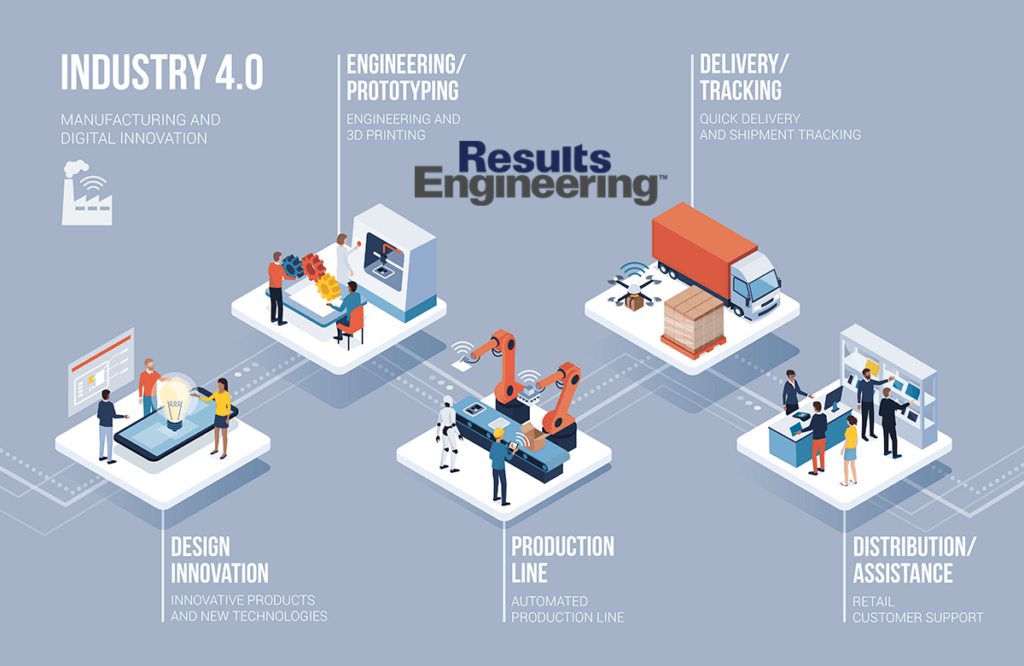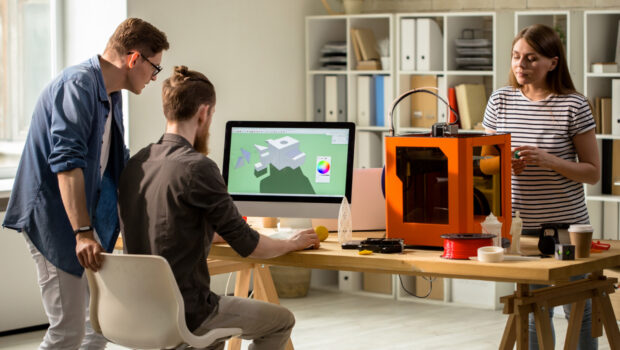Latest 3D Modeling Industry Developments
3D modeling is actively developing, its application has long gone beyond the scope of 3D films, and what was considered something unthinkable just yesterday is becoming a mass phenomenon now. Today, 3D modeling has become an integral part of many manufacturing processes. We are standing on the cusp of a new revolution: Industry 4.0 is here!

Image credit: Stokkete, Envato Elements
Industry 4.0
The widespread automation and robotization of production processes in the global industry began in the 1970s. Analogous to the industrial revolution in the late 18th century (the invention of steam power and mechanical devices) and the invention of electrical energy in the 19th century, this period is commonly called the third industrial revolution. It would seem that fantasy has already become a reality: 15-20 years ago, not a single enterprise manager could dream of the level of labor productivity that automation ensured. However, today we understand that a mechanism has been launched, perhaps even more ambitious changes that will once again turn our lives upside down.

Image Credits: resultseng.com
The concept of “Industry 4.0”, or the Fourth Industrial Revolution, provides for the end-to-end digitalization of all physical assets of an enterprise and their integration into a single ecosystem. It seems to be a new paradigm – new opportunities for everyone. First of all, Industry 4.0 involves the massive introduction of artificial intelligence in industry and the large-scale automation of business processes. In this regard, 3D printing, AI, AR/VR, IoT, and neurotechnologies are becoming the engines of this revolution. Remarkably, the hype around the Metaverse turns 3D modeling into an important point in the development and establishment of Industry 4.0. But first, let’s study the evolution, application, and prospects of 3D modeling to determine where it is going and, most importantly, where it will take us.
3D printing trends you should know
Until recently, 3D printing was too expensive: the equipment cost fabulous sums, and only a few narrow specialists knew the software. But the situation has changed radically. The technology has proven its effectiveness not only in mechanical engineering but also in architecture and construction, medicine, jewelry, etc. Here are a few trends in 3D printing
Architecture
3D printed models of real buildings won’t surprise anyone. Today, in the context of new technologies, we are no longer talking about printing individual blocks; the ability to print entire houses is becoming a trend.
The medicine
3D printing has received the greatest use in dentistry and prosthetics. However, the ultimate goal of the technology is bioprinting or printing of living organs.
Light industry
The fashion of the future will depend on the development of additive technologies. Fashion designers are using the possibilities of 3D printing to the fullest to implement extravagant and extraordinary ideas.
Heavy industry, electronics, space industry
Creating parts for very complex and high-tech structures using 3D technologies is already a reality. The development of industries that form the basis of our civilization – from the creation of microcircuits to the development of engines – moves along with additive technologies.
Metaverse
Humanity is on the way to transition from the material world to the digital one, and the hype around the metaverse only showed evidence of the trend. It’s no surprise that 3D modeling is getting more popular – someone has to create the objects of the new reality!
Latest breakthroughs in 3D modeling
Аdditive technologies are growing rapidly, becoming real game-changers of the future. Now, businesses and consumers are increasingly choosing eco-friendly products and packaging, which has an impact on supply chains. 3D modeling enables businesses to adopt more sustainable manufacturing practices, using 3D printing, from a design process to a carbon-neutral manufacturing process.
Decathlon’s Additive Manufacturing Laboratory (ADDLAB) manufactures spare parts and develops design prototypes for Decathlon products. This digital manufacturing is reshaping several large industries, driving innovation, and creating new value for businesses and consumers.
Healthcare is another industry that is highly affected by 3D modeling. For example, the team at the University of Utrecht pioneered the technique of volumetric bioprinting, obtaining tissue structures of arbitrary shape. This is a breakthrough as it differs from known bioprinting methods. Instead of layer-by-layer deposition and assembly of repetitive building blocks, the Utrecht team uses the projection of a series of two-dimensional light patterns into a cylindrical container filled with photosensitive hydrogel-containing cells that trigger polymerization.
Another remarkable breakthrough is the first “Parametric modeling art hub”, BeeGraphy which provides unique innovative tools for 3D and CAD designers, manufacturers, etc. It’s the world’s first online/cloud-based parametric/algorithmic modeling software classified as a node editor, where the user interface of the modeling software contains non-standard tools for design software. Moreover, thousands or even millions of variations out of one generated model can be created through parametric changes, which is the best aspect of parametric/algorithmic modeling in the 3D modeling industry. The breakthrough of BeeGraphy Editor software is that it allows real-time online collaboration on product modeling, and drafting.
Our 3D future
2021 can safely be called a year of Metaverse. It received an incredible hype that showcases the wide interest in 3D modeling. No wonder, someone has to create the objects of the new reality! Sure, today some metaverses like Decentraland, Roblox, and Somnium Space, allow us to communicate in VR space, have fun, create avatars and even build a collaborative workflow. But this is still only a part of the opportunities that the Metaverse suggests. In the future, three-dimensional avatars will be created using 3D modeling tools that look like real people, repeating the gestures and facial expressions of their owners. The whole surrounding world will be 3D generated. And here we will have to use the technologies of 3D scanning of objects and Motion Capture, which are actively used in the creation of films and games today. Undoubtedly, this opens up a whole bunch of opportunities for 3D modeling. This to-be-created digital reality will become a convergence of physical, augmented, and virtual reality where the world around us will be made in 3D graphics.
Cover Image by Freepik










![Ways to Prospect More Effectively [Infographic]](https://technofaq.org/wp-content/uploads/2017/04/Ways-To-Prospect-More-Effectively-Infographic-150x150.png)





